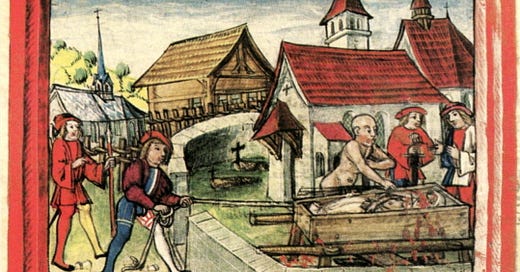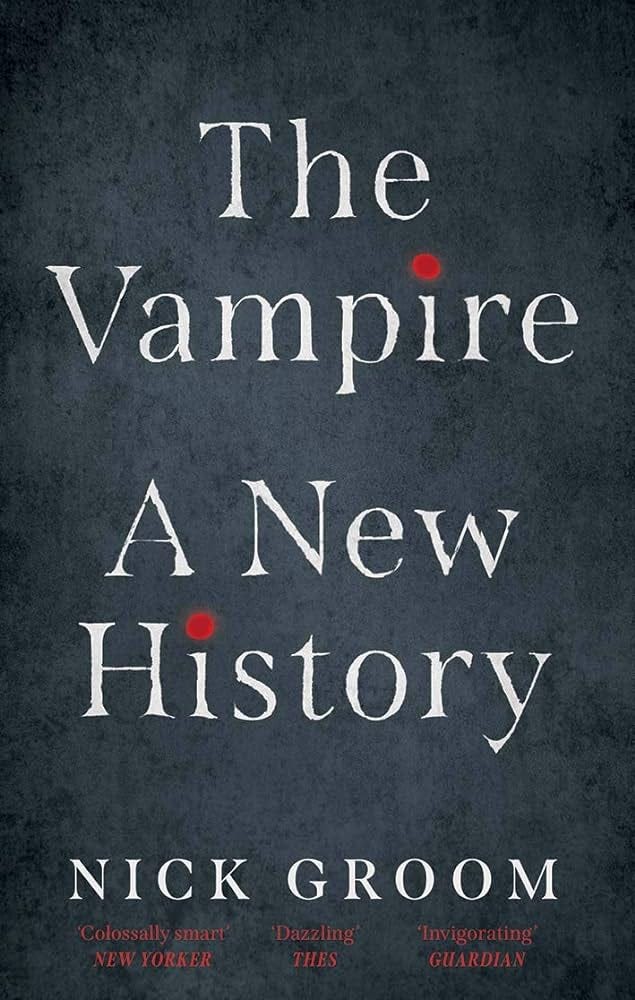Cruentation (from ius cruentationis—“law of bleeding”) is the act of corpses bleeding when in the presence of their murderers. I suspect the belief is reflected as early as the Cain and Abel story, where we’re told that the slain Abel’s blood cries out to God from the ground (Gen 4:10). As I recently discovered in Nick Groom’s fantastically interesting and learned book The Vampire: A New History (New Haven, CT: Yale University Press, 2020), which I’m reading in preparation for writing something on Bram Stoker’s Dracula, the belief apparently remained in vogue as late as the nineteenth century.
Here’s the pertinent selection (pp. 8-10) from Groom’s book. The footnotes are all his. One of the joys of his history is its closely printed and meticulously documented 65 pages of endnotes and bibliography.
BEGIN
Murdered bodies were believed to bleed in the presence of their killer, as noted by Shakespeare in Richard III (c. 1592-93):
O gentlemen, see, see! Dead Henry’s wounds
Ope their congealed mouths and bleed afresh.1
Likewise, in Webster’s Apius and Virginia, Icilius enters with the body of Virginia, declaring:
See
her wounds still bleeding at the horrid presence
of yon stern Murderer, till she find revenge.2
King James VI and I’s Daemonologie (1597), which also recorded incubi possessing dead cadavers in order to rape their earthly lovers, gave the phenomenon of cruentation legal force in the seventeenth century:
as in a secret murder, if the dead carcass be at any time thereafter handled by the murderer it will gush out of blood, as if the blood were crying to the heaven for revenge of the murderer, God having appointed that secret supernatural sign for trial of that secret unnatural crime.3
Such uncanny and apparently proven properties of blood exerted a compelling fascination. It was evident that blood could testify against murderers: it could bear witness. A report of a murder committed in 1629 described how the unfortunate victim, one Jane Norkot, had been discovered with her throat cut and a knife stuck in the floor beside her. A verdict of suicide was given, but a month later the case was reopened, the body exhumed and four members of her family charged with the murder:
her body being take up out of the grave, 30 days after the party’s death, and lying on the grass, and the four defendants being present, were required each of them to touch the dead body. Okeman’s wife fell upon her knees, and prayed God to shew tokens of her innocency. The appellant did touch the dead body, whereupon the brow of the dead, which before was of a livid and carrion colour (in terminis, the verbal expression of the witness), began to have a dew, or gentle sweat, arise on it, which increased by degrees till the sweat ran down in drops on the face; the brow turned to a lively and fresh colour, and the deceased opened one of her eyes, and shut it again; and this opening the eye was done three several times. She likewise thrust out the ring or marriage finger three times, and pulled it in again, and the finger dropped blood from it on the grass.
Witnesses to the event were sure it was fresh blood: one dipped his finger in it as confirmation. Circumstantial forensic evidence also depended on blood: there was no blood in Jane Norkot’s bed ‘saving a tincture of blood on the bolster whereon her head lay,’ but ‘From the bed’s head there was a stream of blood on the floor at the bed’s foot.’ In addition to these two separate bloodstains on the floor, ‘there were clots of congealed blood in the straw of the mat underneath.’ The knife was bloodstained and, most chillingly, ‘There was the print of a thumb and four fingers of a left hand.’4
James Guthrie, a Scottish Presbyterian minister hanged in 1661 following the Restoration of the Stuart monarchy, also bled on the guilty. His corpse was decapitated and the head publicly displayed, but it would shed blood on the coach of the commissioner who had presided at his trial. These bloodstains were impossible to remove: ‘all their art and diligence could not wipe it off.’5 Likewise in 1688, the son of Sir Philip Stansfield was discovered to have murdered him when, on helping to lift the corpse into its coffin, the two-day-old cadaver ‘bled afresh’ on the son’s hands and on no one else’s. Cruentation continued to be cited in criminal law on occasion until the nineteenth century, especially in Scotland.6
END
Cruentation fascinates me because of its insistence that crime will out and the guilty will be exposed, even when courts of law are unable to marshall enough
”normal” evidence to convict. The very nature of the heinous crime of murder is one that so affronts the victim that his or her corpse cries out against it when in the presence of the slayer. There’s also the cognate and equally ancient belief that the reflection of a murderer can be seen in the eyes of his or her victim. Again, justice prevails.
###
William Shakespeare, The Tragedy of King Richard III, in The Oxford Shakespeare: The Complete Works, gen. eds. Stanley Wells and Gary Taylor (Oxford: Clarendon Press, 1988) I.ii.55-56 (p. 187).
John Webster (and Thomas Heywood), Appius and Virgina. A Tragedy (London, 1659), V.i. (p. 59); see MacD.P. Jackson, “John Webster and Thomas Heywood in A[ppius and Virgina: A Bibliographical Approach to the Problem of Authorship,” Studies in Bibliography 38 (1985): 217-35.
James VI, Daemonologie (Edinburg, 1597), Bk III: see Brian P. Levack (ed), The Witchcraft Sourcebook, 2nd edn (London and New York: Routledge, 2015), pp. 160-61.
T.B. Howell, A Complete Collection of State Trials and Proceedings for High Treason and Other Crimes and Misdemeanors from the Earliest Period to the Present Time, 23 vols (London: T.C. Hansard, 1816), xiv, cols. 1825-26.
Ibid., col. 1328.
On cruentation, see Malcolm Gaskill, Crime and Mentalities in Early Modern England (Cambridge: Cambridge University Press, 2000), 203-40; and Margaret Ingram, “Bodies That Speak: Early Modern European Gender Distinctions in Bleeding Corpses and Demoniacs” (MA Thesis: University of Oregon, 2017), 158-59; see also Robert P. Brittain, “Cruentation in Legal Medicine and in Literature,” Medical History 9 (1965): 82-88; Winston Black, “Animated Corpses and Bodies with Power in the Scholastic Age,” in Joelle Rollo-Koster (ed), Death in Medieval Europe: Death Scripted and Death Choreographed (London: Routledge, 2017): 71-92; and Nancy Mandeville Caciola, Afterlives: The Return of the Dead in the Middle Ages (Ithaca, NY: Cornell University Press 2016); see also Paul Barber, Vampires, Burial, and Death: Folklore and Reality. 2nd edn. (New Haven, CT: Yale University Press, 2010), p. 122.






Wow!!!Fascinating